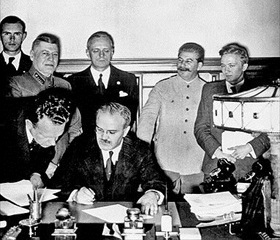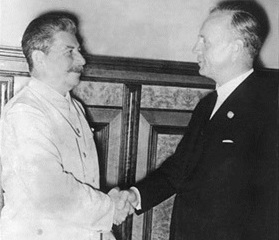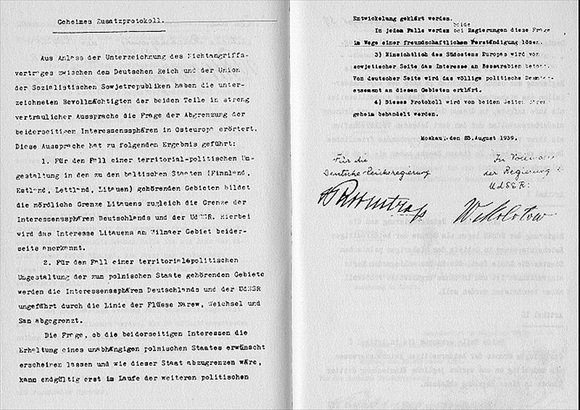THREE BALTIC STATES COERCED INTO SOVIET ORBIT
Moscow, Soviet Union • August 3, 1940
Early on the morning of August 24, 1939, Soviet People’s Commissar on Foreign Affairs, Vyacheslav Molotov, and his German counterpart, Joachim von Ribbentrop, affixed their signatures to the German-Soviet Nonaggression Pact, also known as the Molotov-Ribbentrop Pact. As German dictator Adolf Hitler viewed it, the pact was a “strategic necessity” that secured Nazi Germany’s eastern frontier against any future hostile attentions the Soviet Union might direct westward; it also provided the green light Hitler needed to launch his war of aggression against neighboring Poland.
The Molotov-Ribbentrop Nonaggression Pact contained a secret protocol “in the event of a territorial and political rearrangement” of the states sandwiched between the Soviet Union and Nazi Germany. Under its terms Poland; the three Baltic states of Lithuania, Latvia, and Estonia; and Finland were to be divided into Soviet and German “spheres of influence.” Finland, Estonia, and Latvia were assigned to the Soviet sphere. Poland was to be partitioned after Hitler’s invasion of that country, which came on September 1, 1939. Thus, the western half of Poland was occupied by Germany and the eastern half of Poland came under Soviet occupation. A second secret protocol, dated September 28, 1939, assigned the majority of Lithuania, which bordered on Germany’s East Prussia, to the Soviet Union.
Poland’s military defeat and occupation in September 1939 made it possible for the Soviet Union to impose “mutual assistance treaties” on Estonia (September 28, 1939), Latvia (October 5, 1939) and Lithuania (October 10, 1939). Soviet armed forces established army, air force, and naval bases (closed-off military zones) in each Baltic state—troop numbers always exceeding treaty limits—in effect making them Soviet protectorates.
The next summer a wave of Soviet diplomatic and military provocations unsettled the democratic governments in all three states; their governments were replaced by Moscow-friendly ones after parliamentary elections in which only Soviet-approved candidates were permitted to run. Voter turnout and electoral results were predictable and even ludicrous: compulsory turnout varied from a low of 92.8 percent in Estonia to a high of 99.2 percent in Lithuania. Indeed, in one Lithuanian precinct voter turnout reached 122 percent. After the marionettes of the new “people’s parliaments” were installed, they petitioned the Supreme Soviet in Moscow to allow their sovereign states to become Soviet republics. Lithuania became a Soviet Socialist Republic on this date, August 3, 1940, Latvia on August 5, 1940, and Estonia the next day, August 6.
![]()
![]()
German-Soviet Nonaggression Pact with Secret Protocol, Moscow, August 23–24, 1939
 |  |
Left: Soviet Premier and Foreign Minister Vyacheslav Molotov (1890–1986) signs the German-Soviet Nonaggression Pact, dated August 23, 1939, in Moscow’s Kremlin in the wee hours of August 24. Immediately behind him is German Foreign Minister Joachim von Ribbentrop (1893–1946) and, to the German’s left, is Soviet General Secretary Joseph Stalin (1878–1953). Although the treaty is formally known by the names of its two signatories, it was largely Stalin’s brainchild and marked the first time the Soviet dictator had been personally involved in formulating and negotiating foreign policy.
![]()
Right: Stalin congratulates von Ribbentrop with a warm handshake following the signing ceremony. In 1936 Hitler named von Ribbentrop ambassador to Great Britain, whom his hosts soon nicknamed “Herr von Brickendrop” due to his clumsy diplomacy at the Court of St. James where, in the words of Alfred Rosenberg, Nazi Germany’s arch-priest of National Socialism, he “put everybody’s nose out of joint.” Two years later, in February 1938, Hitler elevated Ribbentrop to head the German foreign ministry on Wilhelmstrasse, where Ribbentrop became just as despised by Berlin’s diplomatic community as he was by England’s. Hitler employed Ribbentrop for the length of the war, perhaps most notoriously at the start when the foreign minister concluded the German-Soviet Nonaggression Pact days before Hitler’s Wehrmacht (armed forces) stormed over Poland’s borders to launch the most lethal conflict of the twentieth century. Rosenberg experienced a foreboding sense for what had transpired in Moscow’s Kremlin: “I have the feeling that this Moscow pact will eventually have dire consequences for National Socialism.” Eventually it did.
![]()
Below: The Molotov-Ribbentrop Nonaggression Pact had an inseparable component, a secret protocol (Geheimes Zusatzprotokoll) that surfaced in the archives of West Germany’s Foreign Office several years after Nazi Germany’s defeat in 1945. Historians sometimes refer to the nonaggression pact as a “pact of aggression,” which Germany debuted on September 1, 1939, and the Soviet Union 17 days later. It destroyed the existing system of bilateral and multilateral nonaggression treaties from the 1920s and ’30s that the smaller European states had with their more powerful neighbors. Latvia, for instance, had a mutual nonaggression pact with Moscow dating to February 1932 and one with Germany signed in Berlin of June 7, 1939. Estonia’s nonaggression pact with Germany was signed in Berlin on the same day as Latvia’s.
 |
Why Germany and the Soviet Union Signed the 1939 Molotov-Ribbentrop Nonaggression Pact: Sets Stage for World War II in Europe
![]()

 History buffs, there is good news! The Daily Chronicles of World War II is now available as an ebook for $4.99 on Amazon.com. Containing a year’s worth of dated entries from this website, the ebook brings the story of this tumultuous era to life in a compelling, authoritative, and succinct manner. Featuring inventive navigation aids, the ebook enables readers to instantly move forward or backward by month and date to different dated entries. Simple and elegant! Click
History buffs, there is good news! The Daily Chronicles of World War II is now available as an ebook for $4.99 on Amazon.com. Containing a year’s worth of dated entries from this website, the ebook brings the story of this tumultuous era to life in a compelling, authoritative, and succinct manner. Featuring inventive navigation aids, the ebook enables readers to instantly move forward or backward by month and date to different dated entries. Simple and elegant! Click 











